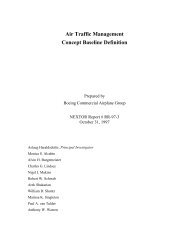Chapter 11: Weather Theory - FAA
Chapter 11: Weather Theory - FAA
Chapter 11: Weather Theory - FAA
Create successful ePaper yourself
Turn your PDF publications into a flip-book with our unique Google optimized e-Paper software.
At the time of departure from Pittsburgh, the weather is VFRwith three miles visibility in smoke and a scattered layer ofclouds at 3,500 feet. As the flight progresses westward toColumbus and closer to the oncoming cold front, the cloudsshow signs of vertical development with a broken layer at2,500 feet. The visibility is six miles in haze with a fallingbarometric pressure. Approaching Indianapolis, the weatherhas deteriorated to overcast clouds at 1,000 feet, and threemiles visibility with thunderstorms and heavy rain showers.At St. Louis, the weather gets better with scattered clouds at1,000 feet and a ten mile visibility.A pilot using sound judgment based on the knowledge offrontal conditions would most likely remain in Indianapolisuntil the front had passed. Trying to fly below a line ofthunderstorms or a squall line is hazardous, and flight overthe top of or around the storm is not an option. Thunderstormscan extend up to well over the capability of small airplanesand can extend in a line for 300 to 500 miles.Comparison of Cold and Warm FrontsWarm fronts and cold fronts are very different in nature asare the hazards associated with each front. They vary inspeed, composition, weather phenomenon, and prediction.Cold fronts, which move at 20 to 35 mph, move very quicklyin comparison to warm fronts, which move at only 10 to25 mph. Cold fronts also possess a steeper frontal slope.Violent weather activity is associated with cold fronts, andthe weather usually occurs along the frontal boundary, not inadvance. However, squall lines can form during the summermonths as far as 200 miles in advance of a severe cold front.Whereas warm fronts bring low ceilings, poor visibility,and rain, cold fronts bring sudden storms, gusty winds,turbulence, and sometimes hail or tornadoes.Cold fronts are fast approaching with little or no warning, andthey make a complete weather change in just a few hours.The weather clears rapidly after passage and drier air withunlimited visibilities prevail. Warm fronts, on the other hand,provide advance warning of their approach and can take daysto pass through a region.Wind ShiftsWind around a high pressure system rotates in a clockwisefashion, while low pressure winds rotate in a counterclockwisemanner. When two pressure systems are adjacent,the winds are almost in direct opposition to each other atthe point of contact. Fronts are the boundaries between twoareas of pressure, and therefore, wind shifts are continuallyoccurring within a front. Shifting wind direction is mostpronounced in conjunction with cold fronts.Stationary FrontWhen the forces of two air masses are relatively equal, theboundary or front that separates them remains stationary andinfluences the local weather for days. This front is called astationary front. The weather associated with a stationaryfront is typically a mixture that can be found in both warmand cold fronts.Occluded FrontAn occluded front occurs when a fast-moving cold frontcatches up with a slow-moving warm front. As the occludedfront approaches, warm front weather prevails, but isimmediately followed by cold front weather. There are twotypes of occluded fronts that can occur, and the temperaturesof the colliding frontal systems play a large part in definingthe type of front and the resulting weather. A cold frontocclusion occurs when a fast moving cold front is colderthan the air ahead of the slow moving warm front. Whenthis occurs, the cold air replaces the cool air and forces thewarm front aloft into the atmosphere. Typically, the coldfront occlusion creates a mixture of weather found in bothwarm and cold fronts, providing the air is relatively stable.A warm front occlusion occurs when the air ahead of thewarm front is colder than the air of the cold front. When thisis the case, the cold front rides up and over the warm front. Ifthe air forced aloft by the warm front occlusion is unstable,the weather is more severe than the weather found in a coldfront occlusion. Embedded thunderstorms, rain, and fog arelikely to occur.Figure <strong>11</strong>-28 depicts a cross-section of a typical cold frontocclusion. The warm front slopes over the prevailing coolerair and produces the warm front type weather. Prior to thepassage of the typical occluded front, cirriform and stratiformclouds prevail, light to heavy precipitation is falling, visibilityis poor, dew point is steady, and barometric pressure isfalling. During the passage of the front, nimbostratus andcumulonimbus clouds predominate, and towering cumulusmay also be possible. Light to heavy precipitation is falling,visibility is poor, winds are variable, and the barometricpressure is leveling off. After the passage of the front,nimbostratus and altostratus clouds are visible, precipitationis decreasing and clearing, and visibility is improving.ThunderstormsFor a thunderstorm to form, the air must have sufficient watervapor, an unstable lapse rate, and an initial lifting action tostart the storm process. Some storms occur at random inunstable air, last for only an hour or two, and produce onlymoderate wind gusts and rainfall. These are known as air<strong>11</strong>-22
















